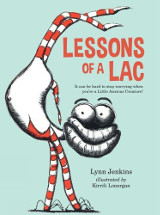Lessons of a LAC by Lynn Jenkins and Kirrili Lonergan

EK Books, 2018. ISBN 9781925335828
In one village on one side of the mountains live the LACs - Little
Anxious Children who constantly look for danger and who only have
negative self-talk; in another village on the other side of the
mountains live their enemies the Calmsters who can take life as it
comes because of their positive self-talk. The two sides are
constantly battling because when one wins, the other shrinks.
One day Loppy the LAC decides to climb the mountain and spy on the
Calmsters but his anxiety goes through the roof when he spies a
Calmster looking back. And not only looking back, but coming to meet
him! Who will win the impending battle? Does there have to be a
winner and a loser?
Anxiety amongst children in on the increase. According to a recent
national survey
of the mental health and wellbeing of Australian children and
adolescents, approximately 278,000 Australian children aged between
4 and 17 struggle with clinical symptoms of Anxiety. (For a summary
see kidsfirst
children's services). Therefore books which shine a light on this
condition which affects 1 in 7 of those between 4 and 17 and which
can be used as a starting point to help the child manage the
symptoms are both important and welcome, particularly as mindfulness
and mental health are gaining traction in school curricula. While
there are almost as many causes of anxiety as there are children
affected by it, such as not being perfect - Perfect
Petunias by Lyn Jenkins, helping children turn their self-talk
around, as Curly did for Loppy, is a critical starting point.
Not only do such explicit statements give the anxious child prompts
for the new words, but they also acknowledge that anxiety is real
and that there are others who are anxious too. While climbing that
internal mountain as Loppy did can be hard, knowing that there are
others who also battle can be reassuring. While teachers are not
clinical psychologists like the author, having tools like the Loppy books in the
mindfulness collection and using them not only to help the Loppies
move forward but also to help the Calmsters learn that some of their
friends may be like Loppy so deserve and need understanding rather
than ridicule can be a starting point in achieving harmony in the
classroom.
Teachers'
notes which extend the story into practical applications are
available.
Barbara Braxton